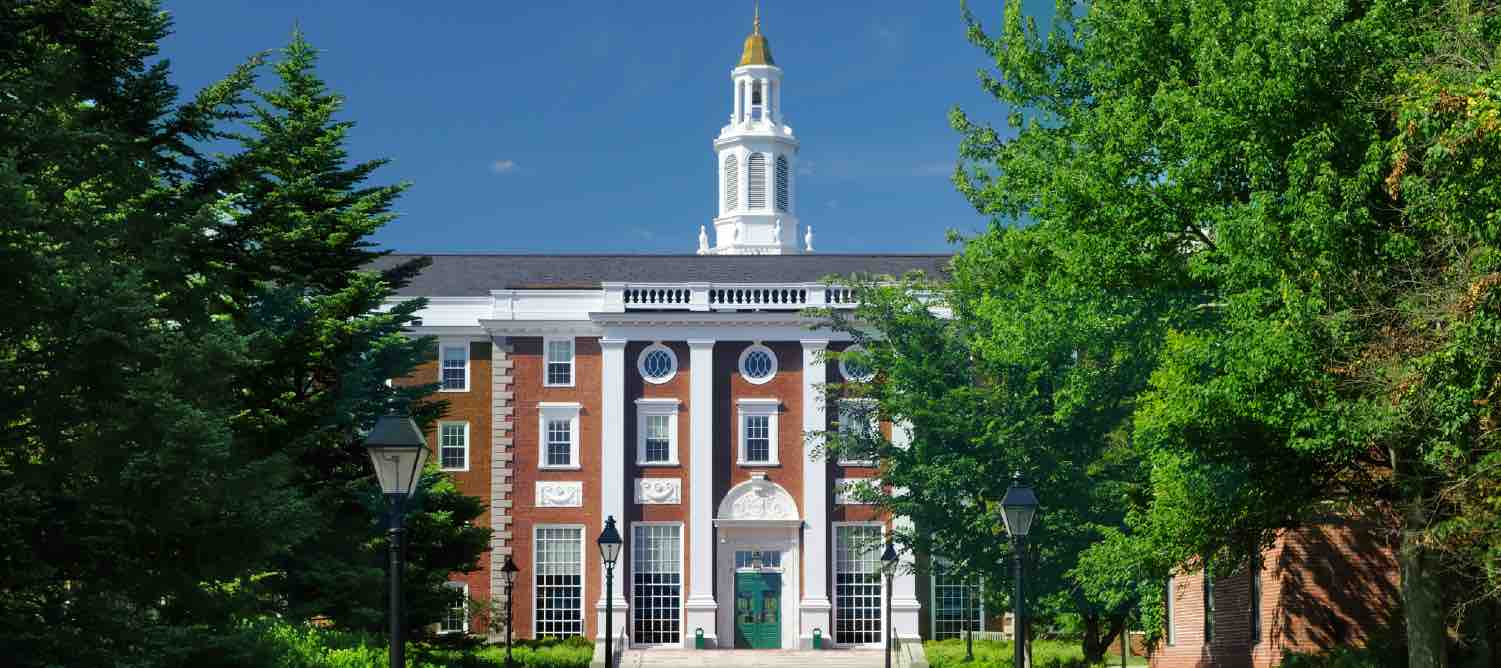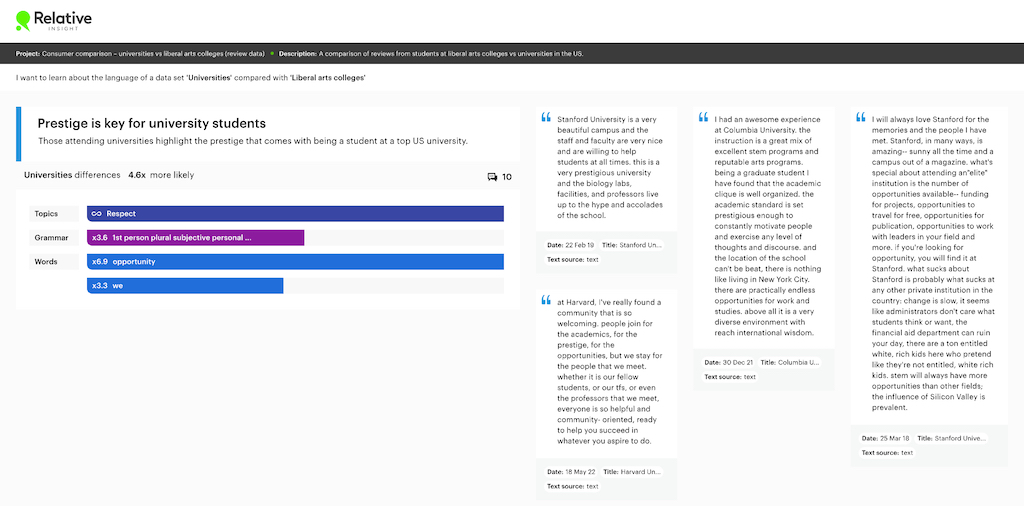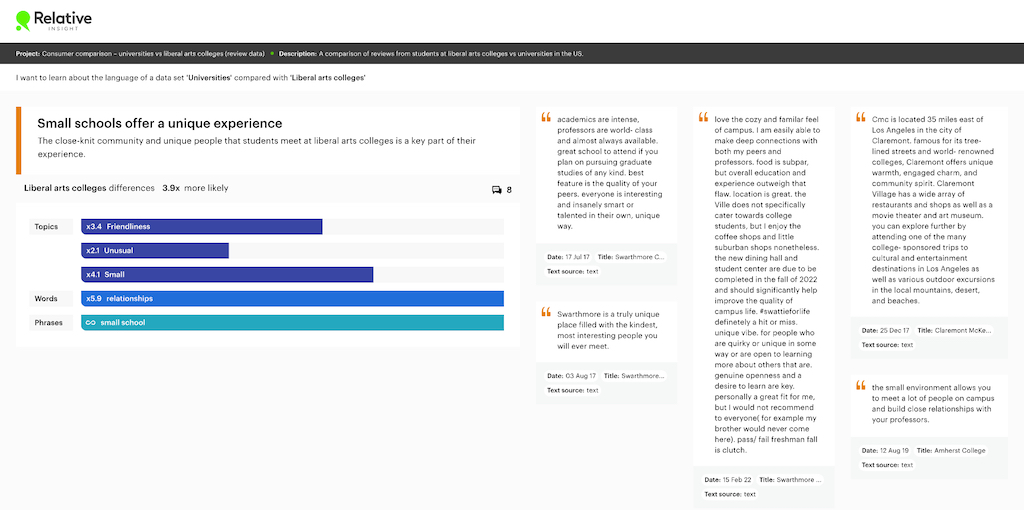Review text analysis: Liberal arts colleges vs. universities

Choosing a college isn’t just about where you’ll spend the next four years. The things you learn, the people you meet and what you experience influence the rest of your life, meaning high school seniors are going to absorb all the information they can – including college reviews. Given this, colleges should consider review text analysis to find out what makes them stand out.
One of the main decisions high school grads need to make is whether they opt for a university or a liberal arts college. There are benefits and drawbacks to both, but understanding high schoolers’ main considerations is vital for colleges to emphasize their selling points to maximize enrollment.
To understand the different motivations for attending liberal arts colleges vs. universities, we decided to conduct a comparison. We took reviews from the five top-rated universities (Harvard, Massachusetts Institute of Technology, Princeton, Columbia and Stanford) and the top-five liberal arts colleges (Williams, Amherst, Swarthmore, Pomona and Claremont McKenna) on US student feedback site Niche and uploaded them to our text analysis platform.
Relative Insight Explore can compare any text data – like consumer reviews – and identify the differences, surfacing what makes audiences unique. When it comes to universities and liberal arts colleges, our review text analysis uncovers some crucial lessons.
Prestige versus setting your own destiny
The nature of the two different types of college mean that people have contrasting reasons for choosing one over the other.
For universities, prestige and honor play a big part in the selection process. Students were infinitely more likely to use words relating to respect like ‘prestigious’, ‘accolades’ and ‘esteemed’ – meaning this language didn’t appear in the liberal arts college reviews. They were also 6.9x more likely to refer to the opportunity of attending these elite institutions.
In addition, students attending universities were 3.6x more likely to use plural first person subjective pronouns – specifically the word ‘we’. They were keen to emphasize that they were part of these big institutions, as much for personal satisfaction as for the people reading their reviews.
“I absolutely love Stanford. It has a legacy that want many students be part of the university… the academic opportunities and resources are unparalleled.“
“Prestigious. Knowledgeable staff. Smart students.“


Smaller liberal arts colleges don’t quite offer the same prestige, but they do offer students more control over their lives. Reviewers were 2.5x more likely use the adjective ‘able to’, highlighting the choices available on campus.
Our consumer analytics found this was down to the consortiums liberal arts colleges form with local counterparts – the phrase ‘five college consortium’ and word ‘consortium’ were infinitely more likely to appear in these reviews – the variety offered by visiting different colleges in a groups was discussed as a key selling point for liberal arts colleges.
“You are really able to take control of your education, and there are more than enough resources to ensure that you are supported.”
“I also love that although it is a small liberal arts college you still get to use the resources from the other schools in the consortium.“
Review text analysis highlights unique communities and facilities
There’s also a key difference in how students discuss the settings and campuses for liberal arts colleges vs. universities.
University attendees were 2.0x more likely to discuss the campus architecture and buildings. These conversations mostly involved where they were staying: they discussed dorms 10.7x more often and talked about housing in general 7.3x more. There was a mixed sentiment among reviewers, with some liking the dorms and others highlighting issues.
“The dining halls, the libraries, and even the dorm hall bathrooms can be terrible experiences due to the high amount of students that consistently frequent these spots.“
“Beautiful campus. Dorm is old. Buildings are old.“
“This is a very prestigious university and the biology labs, facilities, and professors live up to the hype and accolades of the school.“
With liberal arts colleges, students talk less about the buildings and more about the community. They were 3.4x more likely to use words surrounding friendliness and 5.9x more likely to use the word ‘relationships’. The smaller, close-knit community feel of these colleges helps students get to know their colleagues and professors better.
Our text analysis also surfaced that students found this close-knit feel to be different to what they knew. They were 2.1x more likely to use words related to the environment being ‘unusual’, with many remarking that their campus had a unique feel.


“Swarthmore is a truly unique place filled with the kindest, most interesting people you will ever meet.“
“I love the cozy and familiar feel of campus. I am easily able to make deep connections with both my peers and professors.“
Distinct priorities for different colleges
Our text analysis tool was also uncovered the different elements of college life for liberal arts colleges vs. universities that mattered to those leaving reviews.
Liberal arts college attendees were 2.3x more likely to highlight the academics they were learning from. They were also infinitely more likely to use the phrases “stellar academics” and “often available” – demonstrating that it is both their professors’ ability and availability which stands out.
“The professors make time to really get to know you and many of them are often available for office hours.“
“Stellar academics, and an intellectual environment that will nurture the mind and the soul.“
In contrast, our consumer analytics discovered that students at universities were far keener to discuss the extra-curricular clubs and sports teams they could join than anything related to their programs. Their reviews were 7.3x more likely to use the word ‘clubs’ and infinitely more likely to use ‘team’. Conversations focused on the eating clubs students could attend and the range of sports which were available.
“I was on the Columbia university women’s soccer team, and this 4 year experience was one of the best, if not the best, experiences of my life. The team chemistry was great.“
“I also think there is enough entertainment on and off campus with eating clubs on campus.“
Text analysis helps colleges uncover students’ desires
By conducting review text analysis, we have a greater understanding of what college students like and dislike about liberal arts colleges vs. universities. Colleges can use this information to improve their marketing messaging and address students’ concerns.
Universities should look to showcase their range of clubs and sports teams to attract students. They should also emphasize the opportunities high school grads have when joining them – as well as using imagery to highlight the facilities on offer. However, these organizations should also seek to address concerns raised in these reviews to improve the student experience.
For liberal arts colleges, it’s clear that any messaging needs to highlight how these friendly, close-knit communities offer a unique college experience where it’s easy to build relationships with fellow students and professors – and gives them greater freedom and control over their learning. Descriptions of contact time with “stellar academics” would also be attractive to prospective students. Finally, colleges in a consortium should accentuate that they’re effectively attending multiple institutions in one.
As high school seniors begin the process of choosing their next destination, colleges need to stand out. Our consumer analytics has demonstrated easy ways they can adjust their messaging to do exactly that.
